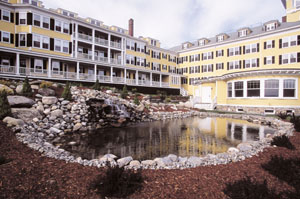
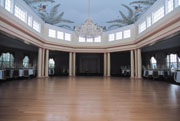
It all began thumbing through the Sunday Boston Globe that the sale of the Mountain View Resort caught the eye of Kevin Craffey, a general contractor of Craffey & Co., and K&J Interiors, a subcontracting firm, both of Hanover, Mass. Originally, Craffey and his wife were looking for a resort home on Martha’s Vineyard but after reading the announcement, they became fascinated with the idea of owning the Mountain View. First thing Monday morning, he placed a call to the realtor, only to find the property was spoken for. For no better reason than interest, Craffey secured a “second dibs” deal with the realtor with a good faith check written for $10,000. The first bid quickly went sour inviting Craffey to step up for opportunity. He and his attorney drove to the property and quickly it became obvious that the project would redefine the phrase, “labor of love.”
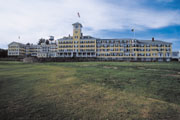
Let the games begin
“I thought, ‘I’m going to try and bring it back to its original grandeur but with the handprints and fingerprints of who we are today’,” says Craffey. “I knew I’d need help. We ran the numbers and it wasn’t a good budget. We went to the State of New Hampshire and received $1 million in grant dollars that we were able to deduct from our construction project. We wrote a bill to the senator and went down through the legislature that would enable property tax abatement for the first five years of the hotel operating—something that was never offered in the state of New Hampshire.“We then went to the federal government and got a grant from the Federal Economic Development Agency. The Secretary of Commerce awarded us a grant of $400,000, but with all that, it was still fiscally irresponsible. Then we went down to the State House, met with the Department of Economic Development, applied and were approved for a low-interest loan of $700,000. Still not enough. We put $4 million of our own equity into the project and then we went to the bank. They weren’t supportive of the idea. It was too speculative.
“We wrote to the bank and they said no, so we went to another bank and they said no,” continues Craffey. “There’s an agency called the Community Development Finance Authority. They can actually invest money as an equity partner to help projects that help communities. We were successfully able to talk the CDFA into issuing us tax credits that could be sold to companies. They issued us $2 million in these credits, which would be another $2 million off of what we’d have to ask a bank for. We went to the bank, they still said no, and then met with Governor Jeanne Shaheen, and the state wrote a guarantee of the loan for 75 percent. So then we went back to the bank and explained we had all the enhancements, we got all these programs, everything’s approved, so we asked for $5 million with 75 percent guaranteed by the state.”
The bank then agreed that if K&J Interiors guaranteed the loan during the construction process, they’d approve the loan and then excuse the company. Craffey agreed and got the loan but it was all hinged on selling the credits. That process took a year and half to do. Craffey then hired an agency to sell the tax credits.
“Well, they couldn’t sell them,” says Craffey. “We got a call from the bank. I said I was a drywall contractor; I wasn’t going to sell tax credits. Then Governor Shaheen personally contacted me and asked me to do it. So I agreed, and there were two deadlines: the first was $300,000 that had to be sold within seven days of contact notice; the other $1.7 million had to be sold within 40 days of the date they notified me.
“So, we hired temporary workers, set up a phone system in the hotel and had them start calling. The deal was, ‘You pay taxes—I got these credits. Instead of paying taxes, you buy these credits and your tax dollars go to work on this hotel. Isn’t that better than not knowing where your tax money goes?’ The drawback was they only got 75 cents of credit per $1. It was a tough sell. For the first sell, we called all these people locally. The very last day, National Public Radio helped us out with a radio spot. The people of the town—the local businesses—all these people came in with little checks to help. We just made it.”
This left the company 40 days left to sell the larger sum. Two weeks before the deadline, another $100,000 was sold. At this point the project looked hopeless.
“So, I sent home the temp workers, held a press conference and said, ‘The fate is in the state’,” says Craffey. “I went home and had a big dinner with the family and they knew how hard everyone had worked. I said, ‘I quit.’ My six-year old daughter came up and hit me as hard as she could, and said, ‘Daddy, you told me winners don’t quit’.”
After continuous roller coaster events reeling in and then pushing away the dream for the purchase and renovation of the Mountain View, Craffey came to a crossroads. En route to Los Angeles to oversee a project for a Vans Skateboard Park, his gnawing dilemma came to a climax where he stood up, asked for the passengers’ attention, and requested five volunteers to hear out his story. Assembled in the back of the plane, Craffey bought a round and laid out his plight to the objective panel. After explaining the hardships of his dream to the jury, he asked that they cast a vote—which he would honor either decision—as to whether he should continue or abort the mission. The ballot came back 3:2, with the former being in favor of his pursuit.
Not even stepping out of the airport, Craffey immediately got a flight back to Boston, chartered a private plane up to the hotel, called a meeting with the handful of employees he had working there, and said, “All or nothing. We gotta make this happen.”
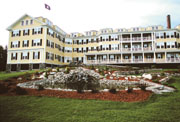
Nick of time
At that point, he had six days left. They called Coca-Cola, Pepsi and other Fortune 500 companies; anyone that was big and had deep pockets. Then he thought back to his businesses and what companies could help. National Gypsum came to mind. The company had a plant in Portsmouth, N.H. A gentleman named Mo Dichard returned his call.Dichard, area sales manager for the northeast region, thought the call was for previous business he had 20-years back at the Mountain View. It turns out he holds the course record from a game back in 1980. Dichard, who was then a pro golfer, found the call only too coincidental.
“Craffey’s name didn’t ring a bell with me,” says Dichard. “I thought the place had burned down. Kevin explained to me about the tax credits and how he wanted to renovate it. I got in touch with Bill Parmelee, the CFO of National Gypsum, because what Kevin was talking about was beyond my scope. Bill thought there was some merit but he wanted to research it on the Web site of New Hampshire. After the research, he reported to me it was legit. So, he had Kevin call him to discuss the project.”
“Kevin called me and laid out the situation, and had done a good job working with the New Hampshire folks,” says Parmelee. “My tax department made a couple calls to the state regarding the project. Because we have a plant in the state we pay a tax. So, the pitch was to the extent you make contributions to the project, you would be able to take a credit at which you would be able to use against the state’s tax. A $1.2 million figure was the amount we agreed to.
“We also needed to address the mechanics of the tax program,” says Parmelee. “So our tax department spent time with the state and then made a presentation with me and our CEO.”
With an exhaustingly close time crunch to meet the final deadline from the state, Dichard got a call that he had to be up at the Mountain View to represent the company for press: National Gypsum had agreed to purchase the credits.
With a dramatic timetable that left Craffey perplexed and joyous, the hang-ups as to whether the project could be continued were confirmed. The next obstacle was the actual renovation. Because of his role as a contractor and not just an investor, Craffey was able to contract a lot of the work to himself.
Miles of walls
Among the projects of the renovation, it is recorded that 937 windows were removed with 5,622 panes re-glazed, sanded and painted. The seven layers of wallpaper dating back 135 years were removed with an area of 2,520,000 square feet. For its exterior, 78 miles of cedar siding was restored and painted with the original colonial yellow. National Gypsum assisted with free technical support for its wallboard installation.
Craffey says that every type of wall system was a part of the structure at one time: horsehair plaster, OSB board, drywall, rock lath, etc. His crew built mock-ups and tested different styles of walls to see which would work the best. After consideration, they settled that using wallboard would work best. It had the look and offered durability.
“We wanted something that could handle a flung suitcase,” says Craffey, explaining his contingency plan that anything from battling lovers to kids playing around could be a part of the lodging experience and wanted an abuse-resistant system. “In a properly lit room I feel drywall has a better look. We could’ve done blueboard with skimcoat but we chose to use modern tools—bazookas, boxes, mud—along with the drywall for a better look.”
To address the potential of cracked beads months down the road, creative solutions were thought of in advance.
“Where the building has movement we used both paper and mesh depending where it went,” says Craffey. “Mesh tape you can almost do a two-coat system. That’s why we used both. The benefit to that is when we went into the millwork and started putting in crown molding, baseboard and new doors, we were able to straighten it out. If the wall was beyond 1⁄2 inch out of 8 feet, we would plumb and then correct it. With modern tolerance it is a 1⁄16-inch to correct.
“We utilized a company that offers a texture called Permatex,” he continues. “That gave us an orange peel effect. By applying this texture to the walls it made the guest rooms look pristine. We came in and sprayed it all on with a Mach 5. We were going to apply a texture of plaster, but the method of texture with the Permatex was durable. We did use joint compound for the ceilings and that way nothing would bump into it. We did our Level 5 finish, and then put all the texture on top of that.”
After a three-year battle, the hotel in Whitefield reopened its doors in May, 2002. Members of the Dodge family—the original owners—were in attendance, along with the locals of the town and Craffey’s crew. As of press time, the hotel had just had its first wedding there that of an area TV newscaster.
For a building that had previously hosted six presidents (both Roosevelts, Coolidge, Hoover, Cleveland and Eisenhower) and had Thomas Edison personally come to install electricity following the resource’s inception, Craffey takes great pride as not only the new owner, but also as a revivalist of something timeless. It’s a registered historic landmark, recognized on city, state and national levels, and reflects many turn-of-the-century accents (including a speakeasy) yet offers something of today’s technology and social context.
All in all, it is quite a feat to continue a renovation, as everyone knows the process is an ongoing relationship. In a century’s time, it will be interesting to know who the next generation’s proprietors will be, what historic codes they will honor, and what advancements they can make. W&C


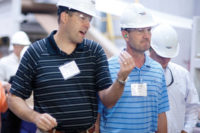
Report Abusive Comment